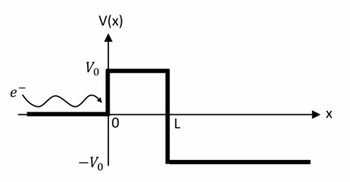
College Physics
11th Edition
ISBN: 9781305952300
Author: Raymond A. Serway, Chris Vuille
Publisher: Cengage Learning
expand_more
expand_more
format_list_bulleted
Question
4. In this question we will be applying the knowledge we gained drom the Finite Potential Step to the system below :
(see figure below)
This potential takes the value V = 0eV when x < 0 , the value V = V0 when 0 < x < L , and the value −V0 when x > L . A beam of electrons with energy E is incident upon it from the left .
A ) According to classical physics , what is the probability that electrons with energy E < V0 will make their way past this barrier ? Explain your answer .

Transcribed Image Text:e
V(x)
Vo
-Vo
0
1
X
Expert Solution
This question has been solved!
Explore an expertly crafted, step-by-step solution for a thorough understanding of key concepts.
Step by stepSolved in 2 steps

Knowledge Booster
Learn more about
Need a deep-dive on the concept behind this application? Look no further. Learn more about this topic, physics and related others by exploring similar questions and additional content below.Similar questions
- Electrons with a speed of 1.4×106 m/sm/s pass through a double-slit apparatus. Interference fringes are detected with a fringe spacing of 2.4 mmmm . Part A What will the fringe spacing be if the electrons are replaced by neutrons with the same speed? Express your answer in micrometers. ΔynΔyn = 1.30•10−6 μmμm SubmitPrevious AnswersRequest Answer Incorrect; Try Again; 4 attempts remaining Part B What speed must neutrons have to produce interference fringes with a fringe spacing of 2.4 mmmm ? Express your answer in meters per second.arrow_forwardNo Spacing Heading 1 Normal Aa v A A 困、 Paragraph Styles The action along a path is defined to be: S = [(K.E.-P. E.) dt Determine the physical units of action. Detail Feynman's approach to calculating the probability amplitude for an electron to go from one event A to another B using the "sum over all paths". A'Focus 12 1> 12arrow_forwardSmall particles in the quantum world are... : actually particles, but look like waves actually waves, even though they look like particles are both waves and particles at the same time my brain hurts and I'm taking an L on this one. I'm out.arrow_forward
- A proton is in an infinite box in the n =2 state and its energy is 1.71MeV. How much energy must be added to the proton to put it in a state with n =13 (in MeV)?arrow_forwardWhat constraints does the uncertainty principle place on our knowledge of the world? To get a sense of scale, we’ll look at the uncertainty in speed for a confined electron and for a confined dust particle.a. What range of velocities might an electron have if confined toa 0.30-nm-wide region, about the size of an atom?b. A 1.0@mm@diameter dust particle (m ≈ 10-15 kg) is confined within a 5-μm-long box. Can we know with certainty if the particle is at rest? If not, within what range is its velocity likely to be found?arrow_forward4. A simple model of a radioactive nuclear decay assumes that alpha particles are trapped inside a nuclear potential well. An alpha particle is a particle made out of two protons and two neutrons and has a mass of 3.73 GeV/c². The nuclear potential can be modeled as a pair of barriers each with a width of 2.0 fm and a height of 30.0 MeV. Find the probability for an alpha particle to tunnel across one of the potential barriers if it has a kinetic energy of 20.0 MeV.arrow_forward
- A quantum system has a ground state with energy Eo = 0 meV and a 2-fold degenerate excited state with energy E₁ = 50 meV. E1 Calculate the probability of finding the system in its ground state when it is at T = 300 K. Select one: O a. 0.78 O b. 0.22 O c. 1 O d. 0.87arrow_forwardThe electron moves in an infinitely deep. potential well with a width of l=0.15 nm. a) Calculate the minimum (i.e. ground state) speed of the electron. V₁=? b) Calculate the reaction force that the electron causes when it moves back and forth and collides with the other wall of the well adiabatically (thermally insulated). F=? c) Calculate the frequency of the electron's back and forth motion. f=?arrow_forwardPart E: At what coordinate(s) do/does the excited neutron have the highest probability of being located? (Select any/all correct answers) a) 0.5 L b) 1 L c) 0.25 L d) 0 L e) 0.75 Larrow_forward
arrow_back_ios
arrow_forward_ios
Recommended textbooks for you
 College PhysicsPhysicsISBN:9781305952300Author:Raymond A. Serway, Chris VuillePublisher:Cengage Learning
College PhysicsPhysicsISBN:9781305952300Author:Raymond A. Serway, Chris VuillePublisher:Cengage Learning University Physics (14th Edition)PhysicsISBN:9780133969290Author:Hugh D. Young, Roger A. FreedmanPublisher:PEARSON
University Physics (14th Edition)PhysicsISBN:9780133969290Author:Hugh D. Young, Roger A. FreedmanPublisher:PEARSON Introduction To Quantum MechanicsPhysicsISBN:9781107189638Author:Griffiths, David J., Schroeter, Darrell F.Publisher:Cambridge University Press
Introduction To Quantum MechanicsPhysicsISBN:9781107189638Author:Griffiths, David J., Schroeter, Darrell F.Publisher:Cambridge University Press Physics for Scientists and EngineersPhysicsISBN:9781337553278Author:Raymond A. Serway, John W. JewettPublisher:Cengage Learning
Physics for Scientists and EngineersPhysicsISBN:9781337553278Author:Raymond A. Serway, John W. JewettPublisher:Cengage Learning Lecture- Tutorials for Introductory AstronomyPhysicsISBN:9780321820464Author:Edward E. Prather, Tim P. Slater, Jeff P. Adams, Gina BrissendenPublisher:Addison-Wesley
Lecture- Tutorials for Introductory AstronomyPhysicsISBN:9780321820464Author:Edward E. Prather, Tim P. Slater, Jeff P. Adams, Gina BrissendenPublisher:Addison-Wesley College Physics: A Strategic Approach (4th Editio...PhysicsISBN:9780134609034Author:Randall D. Knight (Professor Emeritus), Brian Jones, Stuart FieldPublisher:PEARSON
College Physics: A Strategic Approach (4th Editio...PhysicsISBN:9780134609034Author:Randall D. Knight (Professor Emeritus), Brian Jones, Stuart FieldPublisher:PEARSON

College Physics
Physics
ISBN:9781305952300
Author:Raymond A. Serway, Chris Vuille
Publisher:Cengage Learning

University Physics (14th Edition)
Physics
ISBN:9780133969290
Author:Hugh D. Young, Roger A. Freedman
Publisher:PEARSON

Introduction To Quantum Mechanics
Physics
ISBN:9781107189638
Author:Griffiths, David J., Schroeter, Darrell F.
Publisher:Cambridge University Press

Physics for Scientists and Engineers
Physics
ISBN:9781337553278
Author:Raymond A. Serway, John W. Jewett
Publisher:Cengage Learning

Lecture- Tutorials for Introductory Astronomy
Physics
ISBN:9780321820464
Author:Edward E. Prather, Tim P. Slater, Jeff P. Adams, Gina Brissenden
Publisher:Addison-Wesley

College Physics: A Strategic Approach (4th Editio...
Physics
ISBN:9780134609034
Author:Randall D. Knight (Professor Emeritus), Brian Jones, Stuart Field
Publisher:PEARSON